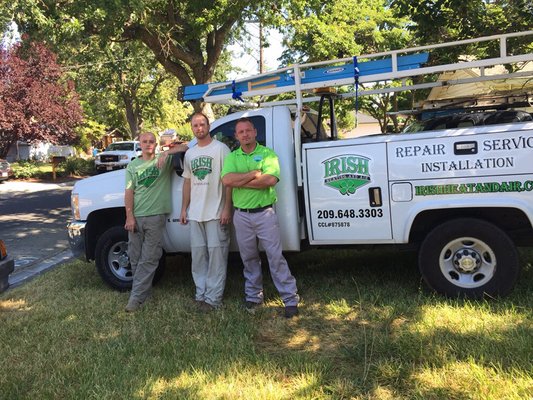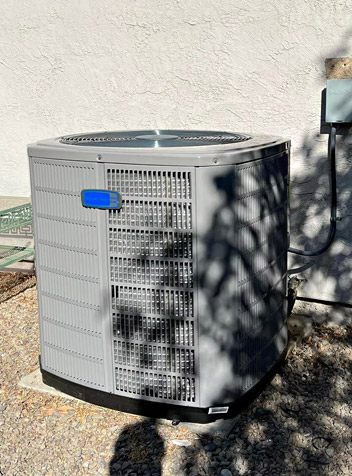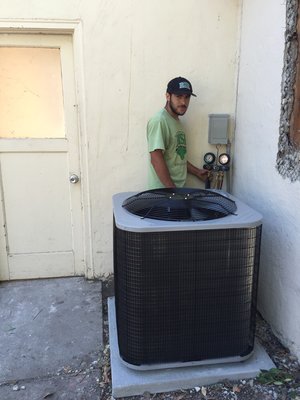Quality Air Conditioning Repair in Mountain House
Proudly servicing air conditioners, furnaces, ducts & commercial HVAC in Mountain House, CA
Is your hot air cold and your cold air hot? Sounds like you’re air conditioner is on the fritz, and you’re in desperate need of an air conditioner repair service! Every air conditioner, whether it’s brand new or a decade old, needs to be serviced regularly. Our professional HVAC technicians will make sure that your air conditioner and furnace are working properly to keep your home or business at the optimum temperature. Never spend another uncomfortably cold winter or unseasonably hot summer when you consider Irish Heating and Air your go-to furnace and air conditioning service provider.

Your Full Service Heating & Cooling Solution
Air Conditioner Repair in Mountain House
Living in Mountain House, hot and arid summers quickly become a fact of life. Fortunately, an efficient air conditioner can greatly alleviate the discomfort that comes with the summer heat. A broken A/C can spell trouble for a home or commercial building in Mountain House, especially between the months of June through September.
With Irish Heating And Air, you’ll never have to worry about dealing with a broken air conditioner again. Our team of professionally trained and certified HVAC technicians comes fully equipped to repair or replace any make or model of A/C system you might have. That includes everything from the latest, most advanced systems to the older, more traditional ones.
Irish Heating and Air have over 15 years of experience in providing reliable A/C repairs in Mountain House and the surrounding area at an affordable price. Over the years, we’ve completed just about every A/C repair imaginable, which is why our team of seasoned A/C repair experts are able to diagnose and complete repairs so efficiently.

What really sets us apart from our competitors though, is our willingness to go the extra mile. Each and every one of our technicians is committed to providing high-quality repairs and exceptional customer service to anyone who calls and requests our services. Not convinced? Check out some of our reviews.

Air Conditioner Installation and Replacement
Whether you’re replacing an old air conditioner that has seen better days, or whether you’re installing an air conditioner for the first time, we’re happy to help.
For standard ducted and central air conditioning, it’s hard to go wrong with American Standard. Their air conditioners offer an exceptional balance of performance, efficiency, reliability, and value. Their compressor sound insulators also allow units to be placed near windows or doors without causing a disturbance, giving you more installation options.
Explore American Standard’s air conditioning products today »

Another great option is the Mitsubishi Electric ductless system. The indoor mini-splits work in tandem with small outdoor heat pumps to provide extremely efficient cooling with extremely customizable home environments.
With a ductless system, it’s easy to stop cooling to one room, set different rooms on different schedules, or apply different cooling rules to different rooms. These systems are the perfect choice if your upstairs gets too hot, or if you want to cool a garage or detached unit.
We Are Your Mountain House Heating & Air Solution
- Commercial HVAC repair and maintenance
- Furnace repair, maintenance, and installation
- Air conditioner repair, maintenance, and installation
- Smart thermostat installation
- And more
Call us today to get started.
Proudly Offering Quality Furnace Repair in Mountain House
Has your furnace been giving you grief lately? Our furnace technicians in Mountain House will quickly remedy your heating and air problems. We are experienced with virtually every brand of furnace, from Arcoaire and Bryant to Carrier and Night and Day, which means our furnace repair team can fix most heating issues within minutes.
Common Reasons Why People Call Our Heating Repair Team
- Poor air flow
- Blocked or dirty air filters
- Bad smells
- Poor energy efficiency
- Slow start up times
- Malfunctioning thermostat
- Faulty pilot light
- Faulty thermostat
- Poor indoor air quality
- Damaged ductwork
- No routine maintenance plan
Because we encounter these issues so often, we are able to fix them with our eyes closed (well, almost!) We can also set you up with a regular maintenance plan to help prevent future more costly repairs, and to nip problems in the bud.
New Furnace Installation
Our first priority is always to save you money and preserve your current furnace, if possible. But if your furnace is fairly old, keeps causing problems, or just isn’t meeting your needs, we can also help you pick out a new furnace that will keep working for years to come. All of our new furnace installations are backed by generous parts and labor warranties, so you’ll be covered no matter what happens.
If you’re looking for an honest, reliable, and knowledgeable heating and cooling company in Mountain House, look no further than Irish Heating and Air.
Learn more about our furnace repair and installation services »
Covering Every Inch of Your Heating System
Burners
Responsible for the combustion process, producing heat.
Pilot Light
Small flame that ignites the main burner.
Heat Exchanger
Transfers heat from combustion gases to the air.
Blower Motor
Circulates air through the furnace and into the living spaces.
Thermostat
Controls the temperature by regulating the furnace’s operation.
Gas Valve
Regulates the flow of gas into the burners.
Ignition System
Starts the combustion process by igniting the burners.
Limit Switch
Monitors the temperature inside the furnace and shuts off the burners if it gets too hot.
Flue Pipe
Allows the expulsion of combustion byproducts from the furnace.
Air Filter
Cleans the air before it enters the furnace, improving indoor air quality.
Ductwork
Channels heated air from the furnace to different areas of the home.
Pressure Switch
Ensures proper airflow by monitoring the pressure in the venting system.
Thermocouple
Safety device that detects the presence of a pilot flame.
Inducer Motor
Assists in the proper venting of combustion gases.
Draft Hood
Ensures the proper venting of combustion gases in atmospheric combustion furnaces.
Circuit Board/Control Board
Regulates and controls various furnace functions.
Sensors (Flame Sensor, Temperature Sensor)
Monitor different aspects of the furnace’s operation for safety and efficiency.
Transformers
Converts voltage to supply power to various components.
Pressure Relief Valve
Releases excess pressure in the furnace.


I cannot thank Ryyan enough for coming out so quickly and fixing our AC unit for us! He was very quick to respond to our request, within less than 20 mins of submitting the request online he responded to me with an opening to come out the next day. We had called a couple other places who never even returned our call. He was incredibly polite and knowledgeable. Our unit is 20+ yrs old, and running on its last leg, so to speak, so he very easily could have lied and told us we needed a new unit, we would have 100% believed him. Instead, he fixed it and said he believes we will be able to get another 1-2 summers out of it. He has earned our loyalty, and we will definitely be using him when we replace our unit. Thank you so much!!
Our HVAC Repair & Installation Team Services Mountain House and Beyond
Are you looking to recommend our services to a friend or family member outside of Mountain House? That’s great! Lucky for you (and your friends), we offer our excellent services to other cities in the surrounding area. Never worry about who to call when you need quality A/C repair services in Mountain House or throughout San Joaquin and Stanislaus counties. Visit our service area page to learn more.
When you save our phone number to your contacts, Irish Heating and Air will always be there to assist you with your air conditioning and furnace needs. We’re ready to start helping you live more comfortably today.
